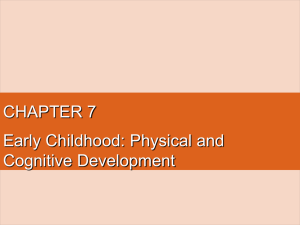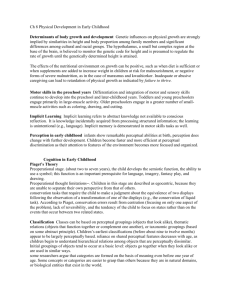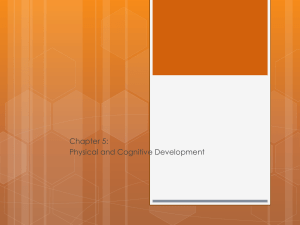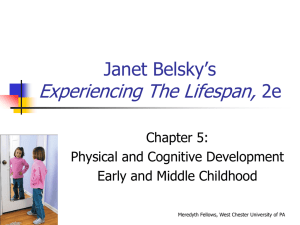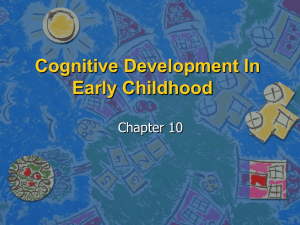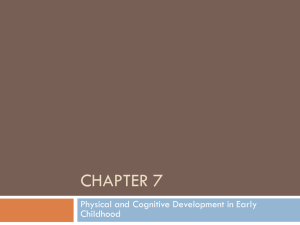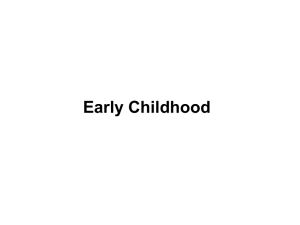Chapter 7 - FacultyWeb Support Center
advertisement
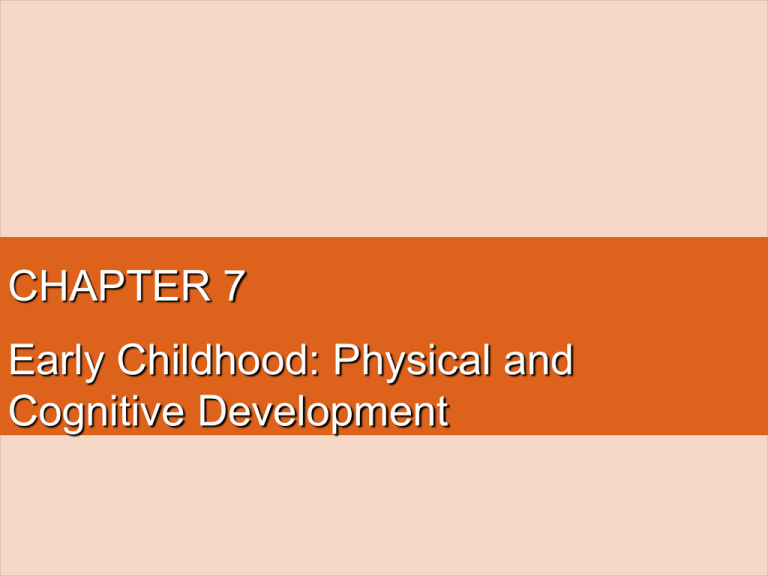
CHAPTER 7 Early Childhood: Physical and Cognitive Development Growth Patterns Growth Patterns • Growth rate -Slows during preschool years -Girls and boys gain 2 to 3 inches in height per year -Weight gains remain fairly even at about 4 to 6 pounds per year -Children become “slender” as height increases -Boys become slightly taller and heavier than girls • Variations are shown from child to child Development of the Brain • Brain -Brain develops more quickly than any other organ during childhood -At 2 years, brain is 75% of adult weight -At 5 years, brain is 90% of adult weight • Increase in brain size due in part to myelination of nerve fibers • Completion of myelination of neural pathways that link the cerebellum to the cerebral cortex helps development of fine motor skills, balance, and coordination. Brain Development (cont’d) • Parts of the brain involved in the ability to sustain attention and screen out distractions have become increasingly myelinated (between ages 4 and 7). • Perseveration » Examples: “Mom,” “Are we there yet…?” • Visual processing speed improves and reaches adult level (at adolescence) • Functions of left and right hemispheres overlap • The hemispheres are aided in cooperation by the myelination of the corpus callosum. - a thick bundle of nerve fibers that connects the hemispheres Brain Development (cont’d) • Plasticity -Brain’s ability to compensate for injuries to particular parts of the brain -Greatest at 1 to 2 years of age • Preschoolers with damage to language areas can overcome them due to plasticity. Motor Development Motor Development • Gross motor skills -Involve large muscles used in locomotion -ex.: balancing on one foot, walking up stairs, pedaling a bike -By age 4 to 5, most older preschoolers have mastered large motor skills. • Boys and girls similar in motor skills -Girls somewhat better in balance and precision -Boys show some advantage in throwing and kicking • Motor experiences in infancy may affect the development of motor skills in early childhood. Physical Activity • Preschoolers spend an average of 25 hours a week in large muscle activity. -Decreases as child ages • Rough-and-tumble play helps develop physical and social skills in children. -Is not the same as aggressive behavior • Physically active parents are likely to have physically active children. -Children of active fathers 3.5 times as likely to be active -Twin studies also suggest there is a genetic tendency for activity level Fine Motor Skills & Children’s Artistic Development • Fine motor skills involve the small muscles used in manipulation and coordination. -Development of drawing is linked to the development of motor and cognitive skills Handedness • Handedness emerges during infancy -By 4 months -clear preference for right hand -By 6 to 14 months -preference to grasping with particular hand increases -By childhood -clear preference for right or left hand • Origins of handedness • If both parents are righthanded, 92% chance that child will be right-handed • If both parents are left-handed, 50% chance that child will be left-handed Health and Illness Nutrition • Nutritional needs vary by age. -1- to 3-year-olds need 1,000 to 1,300 calories a day -Appetite becomes erratic during 2nd and 3rd year of life and caloric needs decrease -4- to 6-year-olds need 1,400 calories a day • • • • Children are often fed too much salt and sugar. Food preferences are somewhat environmental. Repeated exposure to a food increases the liking of it. Parents are the role model for which types of food a child will like to eat. Minor Illnesses • Minor illnesses include -respiratory infections -gastrointestinal upsets -last a few days to a week • These diseases in childhood are normal -Leading killer of children in developing countries is diarrheal illness • American children between the ages of 1 and 3 average eight to nine minor illnesses a year – Between the ages of 4 and 10, the average drops to four to six Major Illnesses • Advances in immunization along with development of antibiotics have reduced and/or eradicated illnesses such as rubella, measles, tetanus, mumps, whooping cough, diphtheria, and polio. • 1/3 of children in the U.S. (younger than 18 years of age) suffer from a chronic illness such as: – arthritis, diabetes, cerebral palsy, or cystic fibrosis • Worldwide, 8 to 9 million children die from: – pneumonia, diarrhea, measles, tetanus, whooping cough, and tuberculosis • Air pollution from the combustion of fossil fuels for heating and cooking causes many respiratory infections. Major Illnesses (cont’d) • Diarrhea -kills nearly 2 million children under the age of 5 each year -is due to unsafe drinking water and poor sanitation/hygiene • Lead exposure -Consuming lead -Breathing in dust from paint with lead in it -Drinking tap water with lead in it -Can contribute to neurological damage and lowered cognitive functioning and other delays in childhood Accidents • Number one cause of death in early childhood -Motor vehicle accidents • Boys -More likely than girls to incur accidental injuries at all ages and in all socioeconomic groups • Poor children -Five times as likely to die from fires -More than twice as likely to die in motor vehicle accidents • High accident rate of low-income children may result in part from living in dangerous housing and neighborhoods. Sleep Sleep Disorders • Sleep terrors -More severe than nightmares -Occur during deep sleep (not during REM) -Begin in childhood; end in late adolescence -Can be associated with stress -May wake suddenly with a surge in heart and respiration rates, talk incoherently; thrash about • Sleep terrors can contribute to child’s fear of going to sleep and insomnia; caretakers have to be understanding and give affection; regular sleep routine helps Sleep Disorders (cont’d) • Sleep walking (somnambulism) -Children may walk, rearrange toys, go to the bathroom, go to the refrigerator -Will have no memory of the activity -Awakening does not cause aggressive behavior -Onset is between ages of 3 and 8 -Occurs during deep sleep -Associated with immaturity of thenervous system Table 7-3, p. 141 • • • • • • • • • • • JACK (age 3) was watching his Mom breast-feeding his new baby sister.... After a while he asked: 'Mom why have you got two? Is one for hot and one for cold milk?' MELANIE (age 5) asked her Granny how old she was.. Granny replied she was so old she didn't remember any more. Melanie said, 'If you don't remember you must look in the back of your panties. Mine say five to six.’ STEVEN (age 3) hugged and kissed his Mom good night. 'I love you so much that when you die I'm going to bury you outside my bedroom window.' BRITTANY (age 4) had an ear ache and wanted a pain killer. She tried in vain to take the lid off the bottle.. Seeing her frustration, her Mom explained it was a child-proof cap and she'd have to open it for her. Eyes wide with wonder, the little girl asked: 'How does it know it's me?’ SUSAN (age 4) was drinking juice when she got the hiccups. 'Please don't give me this juice again,' she said, 'It makes my teeth cough..’ DJ (age 4) stepped onto the bathroom scale and asked: 'How much do I cost?’ CLINTON (age 5) was in his bedroom looking worried When his Mom asked what was troubling him, he replied, 'I don't know what'll happen with this bed when I get married.. How will my wife fit in it?' MARC (age 4) was engrossed in a young couple that were hugging and kissing in a restaurant. Without taking his eyes off them, he asked his dad: 'Why is he whispering in her mouth?’ TAMMY (age 4) was with her mother when they met an elderly, rather wrinkled woman her Mom knew.. Tammy looked at her for a while and then asked, 'Why doesn't your skin fit your face?’ JAMES (age 4)was listening to a Bible story. His dad read: 'The man named Lot was warned to take his wife and flee out of the city but his wife looked back and was turned to salt.' Concerned, James asked: 'What happened to the flea?’ Sunday sermon.....'Dear Lord,' the minister began, with arms extended toward heaven and a rapturous look on his upturned face. 'Without you, we are but dust...' He would have continued but at that moment Sarah, who was listening leaned over to me and asked quite audibly in her shrill little four year old girl voice, 'Mom, what is butt dust?' Jean Piaget’s Preoperational Stage Jean Piaget’s Preoperational Stage • Preoperational stage lasts from age 2 to age 7. • Language ability is the greatest symbolic activity during this stage. -Scribbling/drawing begins at start of this stage • Symbolic play (pretend play) is engaged in from 15 months of age. -Increases in complexity as child ages • Quality of child’s play has long-term implications. -Preschoolers who engage in violent pretend play are less empathic, less likely to help other children, and more likely to engage in antisocial behavior later on Jean Piaget’s Preoperational Stage (cont’d) • 65% of preschoolers have imaginary friends. -More common among first born and only children than children with older siblings • Children with imaginary playmates are -less aggressive, more cooperative, more creative than children without imaginary friends; show better ability to concentrate and are more advanced in language development • Egocentrism -One-dimensional thinking -Think parents are aware of everything that is happening to them -Piaget used “three-mountains” test to measure it -Examples: Mary, stairs, movies, “I’m this many…” Jean Piaget’s Preoperational Stage (cont’d) • Precausal -Unless preoperational children know the natural causes of an event, their reasons are likely to be based egocentrically and not based on science. • Animism -Attribution of life and intentions to inanimate objects -Examples: Curb, dolls • Artificialism -Assumes environmental factors such as rain and thunder have been designed and made by people Jean Piaget’s Preoperational Stage (cont’d) • Preoperational child has difficulty making distinctions between mental and physical events; may believe dreams are real • Can only focus on one dimension at a time – Examples: Colors vs. shapes, dogs, photos • Conservation -Law that holds that properties of substances such as volume, mass, and number remain the same even if you change their shape or arrangement -Attainment of this skill moves the child into concrete operational stage • Preoperational child has not mastered reversibility – Examples: Coloring, hamburger Jean Piaget’s Preoperational Stage (cont’d) • Class inclusion -Including new objects or categories in broader mental classes or categories -Requires child to focus on two aspects of a situation at once -This skill not observed during preoperational stage Factors in Cognitive Development Vygotsky’s Factors in Cognitive Development • Scaffolding -Temporary support provided by a parent or teacher to learning children -Guidance by adult decreases as child is capable of carrying out task on their own -Examples: Painting, letters • Zone of proximal development (ZPD) -Vygotsky’s term for the situation in which a child carries out tasks with the help of someone who is more skilled -Gap between what children are capable of doing now and what they could do with help from others -Adults or older children help in guiding by gearing assistance to children’s capabilities -Examples: Puzzles, reading The “HOME” Environment • HOME -Home Observation for the Measurement of the Environment -Caldwell et al. (2003) developed measure for evaluating children’s home environments -Contains six subscales -Better predictor of young children’s IQ than social class, mother’s IQ, or infant IQ scores -Home environment is connected with occupational success as an adult • Factors such as parental responsiveness, stimulation, encouraging independence of preschooler are connected with higher IQ scores and greater school achievement. Effects of Early Childhood Education • Preschool education enables children to get an early start on achievement in school. • Children from lower SES -show lower performance on standardized intelligence tests -are at greater risk for school failure • Effects of preschool intervention programs -Studies of Head Start and other enrichment programs show that environmental enrichment as well as parent education can enhance the cognitive development of economically disadvantaged children. Television • U.S. children spend more time watching television than they do in school. – 3-year-olds watch 2 to 3 hours of TV per day • Children’s programming – Shows mild to moderate effects on preschoolers’ cognitive development (differs for under 2 years) • Sesame Street – Regular viewing increases children’s learning of numbers, letters, and cognitive skills Theory of Mind Theory of Mind • Preschoolers can accurately predict and explain human action and emotion in terms of mental states. • Preschoolers can separate their beliefs from those of another person who has false knowledge of a situation by age 4 to 5. – Examples: Mean monkey, M&Ms • By age 4, children understand that senses contribute to understanding qualities of an object. • Appearance-reality distinction -Understanding the difference between real events and mental events Development of Memory Development of Memory • By age 4, children can remember events from 1 1/2 years earlier. • Scripts -Young children form scripts when describing what happens during a particular event. -Script becomes more elaborate as it is told • Autobiographical memory (episodic memory) -Memory or specific events is facilitated by children talking about them with others • Parental interest and questioning increases preschooler’s memory. Development of Memory (cont’d) • When preschoolers are younger, they remember more than they reported. • Verbal reports used to measure accuracy of preschoolers’ memory appear to underestimate their memory. • Rehearsal -Memory strategy using repetition; engaged in around 5 years • Sorting objects enhances preschoolers’ memory. • Memory strategies advance during middle childhood. Language Development: Why “Daddy Goed Away” Development of Vocabulary • Preschoolers learn an average of 9 words a day. • Fast-mapping -Process where child quickly attaches a new word to its appropriate concept • Whole-object assumption -Assume that words refer to whole objects and not to their component parts or characteristics • Contrast assumption -The assumption that objects have only one label Development of Grammar • Children’s sentence structure increases during 3rd year of life • Overregularization -Children acquire grammatical rules as they learn language; young ages apply rules rigidly -Reflects accurate knowledge of grammar • Certain “wh” questions (what, who, where) appear earlier than others (why, when, which, how). • Passive sentences are difficult for 2- and 3-year-olds. Pragmatics and Language • Pragmatics -Practical aspects of communication -Children demonstrate pragmatism when they adjust speech to fit the social situation • Language and cognitive development are interwoven. • Piaget maintained cognitive development precedes language development. -Children learn the word and then apply it to the category • Research on which develops first is inconclusive • Vygotsky maintained that vocalizations and thoughts are separate during the first year. • Inner speech -Spoken aloud thoughts are internalized
